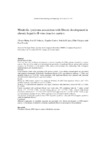Mostrar o rexistro simple do ítem
Metabolic syndrome association with fibrosis development in chronic hepatitis B virus inactive carriers
| dc.contributor.author | Mena, Álvaro | |
| dc.contributor.author | Pedreira, José D. | |
| dc.contributor.author | Castro-Iglesias, Ángeles | |
| dc.contributor.author | López, Soledad | |
| dc.contributor.author | Vázquez-Rodríguez, Pilar | |
| dc.contributor.author | Poveda, Eva | |
| dc.date.accessioned | 2017-04-25T07:29:31Z | |
| dc.date.available | 2017-04-25T07:29:31Z | |
| dc.date.issued | 2013-12-19 | |
| dc.identifier.citation | Mena A, Pedreira JD, Castro A, López S, Vázquez P, Poveda E. Metabolic syndrome association with fibrosis development in chronic hepatitis B virus inactive carriers. J Gastroenterol Hepatol. 2014; 29(1):173-178 | es_ES |
| dc.identifier.issn | 0815-9319 | |
| dc.identifier.issn | 1440-1746 | |
| dc.identifier.uri | http://hdl.handle.net/2183/18427 | |
| dc.description.abstract | [Abstract] Background and Aim. There are few data of fibrosis development in chronic hepatitis B (CHB) patients classified as inactive carriers. The aim of this study is to determinate the prevalence of significant fibrosis and probable cirrhosis measured by FibroScan in real inactive CHB carriers and investigate the relationship with virological, epidemiological, and metabolic factors. Methods. Cross-sectional cohort study including CHB inactive carriers. Liver stiffness measurement was performed with transient elastography (FibroScan). Significant fibrosis (≥ F2) was defined as stiffness > 7.5 kPa, and probable cirrhosis as > 11.8 kPa. Factors associated with significant fibrosis were explored with univariate and multivariate adjusted logistic regression analyses. Results. Ninety-six CHB inactive carriers were analyzed. Of them, 24 (25%) had significant fibrosis and 7 (7%) probable cirrhosis; mean stiffness was 6.2 ± 2.3 kPa. Of them, 24% had metabolic syndrome, with higher FibroScan value than those without (8.4 kPa vs 5.5 kPa, P < 0.001). Factors associated with significant fibrosis were (odds ratio, 95% confidence interval, P value): central obesity (7.1, 1.8–27.9, 0.005), elevated fasting glucose (4.3, 1.3–27.9, 0.036), reduced high-density lipoprotein cholesterol (5.2, 1.2–23.6, 0.032) and elevated triglycerides (6.2, 1.4–28.3, 0.019). Factors as age, sex, transaminases, hepatitis B virus DNA or genotype were not related with liver fibrosis. The presence of metabolic syndrome has a 69% of positive predictive value and 89% of negative predictive value for significant fibrosis. Conclusion. Different components of metabolic syndrome are associated with fibrosis development in CHB inactive carriers. In the absence of metabolic syndrome, significant fibrosis is uncommon in this population. | es_ES |
| dc.description.sponsorship | Instituto de Salud Carlos III; CP08/00214 | es_ES |
| dc.description.sponsorship | Instituto de Salud Carlos III; PI10/02166 | es_ES |
| dc.language.iso | eng | es_ES |
| dc.publisher | Wiley | es_ES |
| dc.relation.uri | http://dx.doi.org/10.1111/jgh.12432 | es_ES |
| dc.rights | This is the peer reviewed version of the article which has been published in final form at Wiley Online Library. This article may be used for non-commercial purposes in accordance with Wiley Terms and Conditions for self-archiving | es_ES |
| dc.subject | FibroScan | es_ES |
| dc.subject | Fibrosis | es_ES |
| dc.subject | HBV | es_ES |
| dc.subject | Inactive carriers | es_ES |
| dc.subject | Metabolic syndrome | es_ES |
| dc.title | Metabolic syndrome association with fibrosis development in chronic hepatitis B virus inactive carriers | es_ES |
| dc.type | journal article | es_ES |
| dc.rights.accessRights | open access | es_ES |
| UDC.journalTitle | Journal of Grastroenterology and Hepatology | es_ES |
| UDC.volume | 29 | es_ES |
| UDC.issue | 1 | es_ES |
| UDC.startPage | 173 | es_ES |
| UDC.endPage | 178 | es_ES |
| UDC.coleccion | Investigación | es_ES |
| UDC.grupoInv | Viroloxía Clínica (INIBIC) | es_ES |
| UDC.institutoCentro | INIBIC - Instituto de Investigacións Biomédicas de A Coruña | es_ES |
Ficheiros no ítem
Este ítem aparece na(s) seguinte(s) colección(s)
-
Investigación (FCS) [1293]






